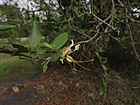Note: This is a project under development. The articles on this wiki are just being initiated and broadly incomplete. You can Help creating new pages.
Cadaba fruticosa
Cadaba farinosa, Cleome fruiticosa, is a slender, evergreen woody plant. It grows up to 5 metres tall. It has a strongly furrowed stem, rarely straight, with a yellowish grey bark. A food preparation made using the leaves of this plant is sold in local markets. The plant also has medicinal uses and is planted for soil stabilization. Also known as capper bush, it is regarded as the sacred tree of the Dwapara Yuga[1].
Contents
- 1 Uses
- 2 Parts Used
- 3 Chemical Composition
- 4 Common names
- 5 Properties
- 6 Habit
- 7 Identification
- 8 List of Ayurvedic medicine in which the herb is used
- 9 Where to get the saplings
- 10 Mode of Propagation
- 11 How to plant/cultivate
- 12 Commonly seen growing in areas
- 13 Photo Gallery
- 14 References
- 15 External Links
Uses
Dysentery, Colds, Various internal disorders, Dermatological conditions, Anthrax.
Parts Used
Chemical Composition
The preliminary phytochemical screening of Cadaba fruticosa showed the presence of plant components such as carbohydrates, tannin, flavonoids, quinines, cardiac glycosides, terpenoids.[2]
Common names
| Language | Common name |
|---|---|
| Kannada | ಮರಗಾಡೆ ಗಿಡ Maragade gida |
| Hindi | Dabi, Kodhab |
| Malayalam | Kattakatti, Viluti |
| Tamil | Uru-vara-c-camatti |
| Telugu | Aadamorinika |
| Marathi | Habab |
| Gujarathi | Kalo katakiyo |
| Punjabi | |
| Kashmiri | |
| Sanskrit | |
| English | Indian cadaba |
Properties
Reference: Dravya - Substance, Rasa - Taste, Guna - Qualities, Veerya - Potency, Vipaka - Post-digesion effect, Karma - Pharmacological activity, Prabhava - Therepeutics.
Dravya
Rasa
Guna
Veerya
Vipaka
Karma
Prabhava
Habit
Identification
Leaf
| Kind | Shape | Feature |
|---|---|---|
| Oval | Round | These leaves are arranged alternately on the branches |
Flower
| Type | Size | Color and composition | Stamen | More information |
|---|---|---|---|---|
| Axillary | 2 to 4 CM | White | Usally in terminal racemes, axillary, solitary | {{{5}}} |
Fruit
| Type | Size | Mass | Appearance | Seeds | More information |
|---|---|---|---|---|---|
| Cylindrycal | Nearly Leathery | Its seeds are round in Shape and Orange in color |
Other features
List of Ayurvedic medicine in which the herb is used
Where to get the saplings
Mode of Propagation
How to plant/cultivate
Succeeds in tropical and subtropical areas at altitudes from sea level to 1,600 metres.[5]
Commonly seen growing in areas
Common in large depressions, Sandy silts of valleys, Around temporary ponds, Stabilized dunes, Termite mounds.
Photo Gallery
References
- ↑ Sacred Plants of India, Nanditha Krisna & M Amirthalingam, Penguin books, 2014
- ↑ Chemical constituents
- ↑ Common names
- ↑ Kappatagudda - A Repertoire of Medicinal Plants of Gadag pdf, Page no - 89
- ↑ Cultivation
External Links
- Ayurvedic Herbs known to be helpful to treat Dysentery
- Ayurvedic Herbs known to be helpful to treat Colds
- Ayurvedic Herbs known to be helpful to treat Various internal disorders
- Ayurvedic Herbs known to be helpful to treat Dermatological conditions
- Ayurvedic Herbs known to be helpful to treat Anthrax
- Herbs with Young leaves used in medicine
- Herbs with Flowers used in medicine
- Herbs with common name in Kannada
- Herbs with common name in Hindi
- Herbs with common name in Malayalam
- Herbs with common name in Tamil
- Herbs with common name in Telugu
- Herbs with common name in Marathi
- Herbs with common name in Gujarathi
- Herbs with common name in English
- Habit - Evergreen shrub
- Index of Plants which can be propagated by Seeds
- Herbs that are commonly seen in the region of Common in large depressions
- Herbs that are commonly seen in the region of Sandy silts of valleys
- Herbs that are commonly seen in the region of Around temporary ponds
- Herbs that are commonly seen in the region of Stabilized dunes
- Herbs that are commonly seen in the region of Termite mounds
- Herbs
- Pages without herbs images





